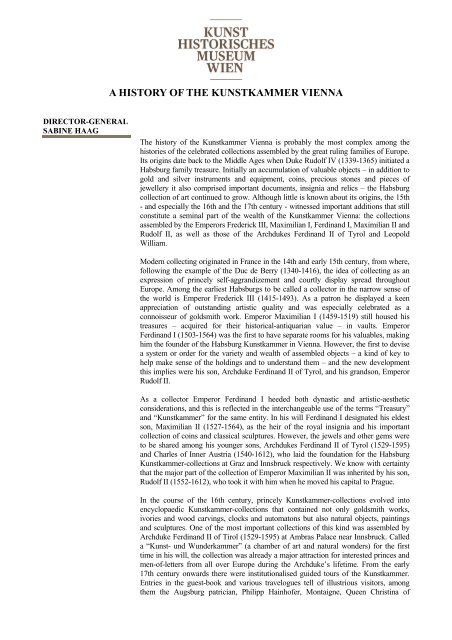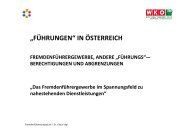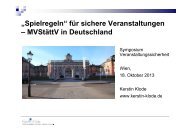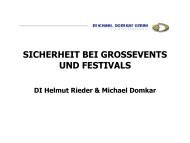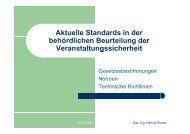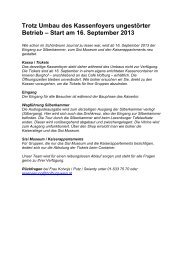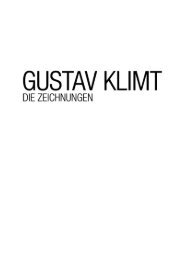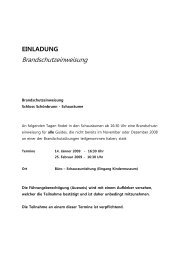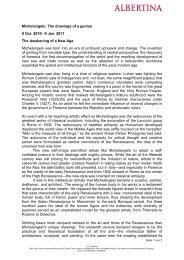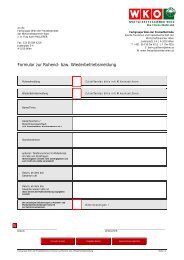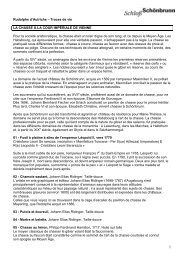kunstkammer vienna the cradle of the museum - Freizeitbetriebe ...
kunstkammer vienna the cradle of the museum - Freizeitbetriebe ...
kunstkammer vienna the cradle of the museum - Freizeitbetriebe ...
You also want an ePaper? Increase the reach of your titles
YUMPU automatically turns print PDFs into web optimized ePapers that Google loves.
DIRECTOR-GENERAL<br />
SABINE HAAG<br />
A HISTORY OF THE KUNSTKAMMER VIENNA<br />
The history <strong>of</strong> <strong>the</strong> Kunstkammer Vienna is probably <strong>the</strong> most complex among <strong>the</strong><br />
histories <strong>of</strong> <strong>the</strong> celebrated collections assembled by <strong>the</strong> great ruling families <strong>of</strong> Europe.<br />
Its origins date back to <strong>the</strong> Middle Ages when Duke Rudolf IV (1339-1365) initiated a<br />
Habsburg family treasure. Initially an accumulation <strong>of</strong> valuable objects – in addition to<br />
gold and silver instruments and equipment, coins, precious stones and pieces <strong>of</strong><br />
jewellery it also comprised important documents, insignia and relics – <strong>the</strong> Habsburg<br />
collection <strong>of</strong> art continued to grow. Although little is known about its origins, <strong>the</strong> 15th<br />
- and especially <strong>the</strong> 16th and <strong>the</strong> 17th century - witnessed important additions that still<br />
constitute a seminal part <strong>of</strong> <strong>the</strong> wealth <strong>of</strong> <strong>the</strong> Kunstkammer Vienna: <strong>the</strong> collections<br />
assembled by <strong>the</strong> Emperors Frederick III, Maximilian I, Ferdinand I, Maximilian II and<br />
Rudolf II, as well as those <strong>of</strong> <strong>the</strong> Archdukes Ferdinand II <strong>of</strong> Tyrol and Leopold<br />
William.<br />
Modern collecting originated in France in <strong>the</strong> 14th and early 15th century, from where,<br />
following <strong>the</strong> example <strong>of</strong> <strong>the</strong> Duc de Berry (1340-1416), <strong>the</strong> idea <strong>of</strong> collecting as an<br />
expression <strong>of</strong> princely self-aggrandizement and courtly display spread throughout<br />
Europe. Among <strong>the</strong> earliest Habsburgs to be called a collector in <strong>the</strong> narrow sense <strong>of</strong><br />
<strong>the</strong> world is Emperor Frederick III (1415-1493). As a patron he displayed a keen<br />
appreciation <strong>of</strong> outstanding artistic quality and was especially celebrated as a<br />
connoisseur <strong>of</strong> goldsmith work. Emperor Maximilian I (1459-1519) still housed his<br />
treasures – acquired for <strong>the</strong>ir historical-antiquarian value – in vaults. Emperor<br />
Ferdinand I (1503-1564) was <strong>the</strong> first to have separate rooms for his valuables, making<br />
him <strong>the</strong> founder <strong>of</strong> <strong>the</strong> Habsburg Kunstkammer in Vienna. However, <strong>the</strong> first to devise<br />
a system or order for <strong>the</strong> variety and wealth <strong>of</strong> assembled objects – a kind <strong>of</strong> key to<br />
help make sense <strong>of</strong> <strong>the</strong> holdings and to understand <strong>the</strong>m – and <strong>the</strong> new development<br />
this implies were his son, Archduke Ferdinand II <strong>of</strong> Tyrol, and his grandson, Emperor<br />
Rudolf II.<br />
As a collector Emperor Ferdinand I heeded both dynastic and artistic-aes<strong>the</strong>tic<br />
considerations, and this is reflected in <strong>the</strong> interchangeable use <strong>of</strong> <strong>the</strong> terms “Treasury”<br />
and “Kunstkammer” for <strong>the</strong> same entity. In his will Ferdinand I designated his eldest<br />
son, Maximilian II (1527-1564), as <strong>the</strong> heir <strong>of</strong> <strong>the</strong> royal insignia and his important<br />
collection <strong>of</strong> coins and classical sculptures. However, <strong>the</strong> jewels and o<strong>the</strong>r gems were<br />
to be shared among his younger sons, Archdukes Ferdinand II <strong>of</strong> Tyrol (1529-1595)<br />
and Charles <strong>of</strong> Inner Austria (1540-1612), who laid <strong>the</strong> foundation for <strong>the</strong> Habsburg<br />
Kunstkammer-collections at Graz and Innsbruck respectively. We know with certainty<br />
that <strong>the</strong> major part <strong>of</strong> <strong>the</strong> collection <strong>of</strong> Emperor Maximilian II was inherited by his son,<br />
Rudolf II (1552-1612), who took it with him when he moved his capital to Prague.<br />
In <strong>the</strong> course <strong>of</strong> <strong>the</strong> 16th century, princely Kunstkammer-collections evolved into<br />
encyclopaedic Kunstkammer-collections that contained not only goldsmith works,<br />
ivories and wood carvings, clocks and automatons but also natural objects, paintings<br />
and sculptures. One <strong>of</strong> <strong>the</strong> most important collections <strong>of</strong> this kind was assembled by<br />
Archduke Ferdinand II <strong>of</strong> Tirol (1529-1595) at Ambras Palace near Innsbruck. Called<br />
a “Kunst- und Wunderkammer” (a chamber <strong>of</strong> art and natural wonders) for <strong>the</strong> first<br />
time in his will, <strong>the</strong> collection was already a major attraction for interested princes and<br />
men-<strong>of</strong>-letters from all over Europe during <strong>the</strong> Archduke’s lifetime. From <strong>the</strong> early<br />
17th century onwards <strong>the</strong>re were institutionalised guided tours <strong>of</strong> <strong>the</strong> Kunstkammer.<br />
Entries in <strong>the</strong> guest-book and various travelogues tell <strong>of</strong> illustrious visitors, among<br />
<strong>the</strong>m <strong>the</strong> Augsburg patrician, Philipp Hainh<strong>of</strong>er, Montaigne, Queen Christina <strong>of</strong>


